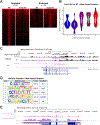Decreased voluntary alcohol intake and ventral striatal epigenetic and transcriptional remodeling in male Acss2 KO mice
- PMID: 39653249
- PMCID: PMC11771284
- DOI: 10.1016/j.neuropharm.2024.110258
Decreased voluntary alcohol intake and ventral striatal epigenetic and transcriptional remodeling in male Acss2 KO mice
Abstract
Metabolic-epigenetic interactions are emerging as key pathways in regulating alcohol-related transcriptional changes in the brain. Recently, we have shown that this is mediated by the metabolic enzyme Acetyl-CoA synthetase 2 (Acss2), which is nuclear and chromatin-bound in neurons. Mice lacking ACSS2 fail to deposit alcohol-derived acetate onto histones in the brain and show no conditioned place preference for ethanol reward. Here, we further explored the role of this pathway during voluntary alcohol intake. We found that Acss2 KO mice consume significantly less alcohol in a model of binge drinking, an effect primarily driven by males. Genome-wide transcriptional profiling of 7 key brain regions implicated in alcohol and drug use revealed that, following drinking, Acss2 KO mice exhibit blunted gene expression in the ventral striatum. Similarly to the behavioral differences, transcriptional dysregulation was more pronounced in male mice. Further, we found that the gene expression changes were associated with depletion of ventral striatal histone acetylation (H3K27ac) in Acss2 KO mice compared to WT. Taken together, our data suggest that ACSS2 plays an important role in orchestrating ventral striatal epigenetic and transcriptional changes during voluntary alcohol drinking, especially in males. Consequently, targeting this pathway could be a promising new therapeutic avenue.
Copyright © 2024 The Authors. Published by Elsevier Ltd.. All rights reserved.
Conflict of interest statement
Declaration of Competing interest Shelley Berger is co-founder of EpiVario, Inc. All other authors report no conflict of interest.
Figures



Similar articles
-
Alcohol metabolism contributes to brain histone acetylation.Nature. 2019 Oct;574(7780):717-721. doi: 10.1038/s41586-019-1700-7. Epub 2019 Oct 23. Nature. 2019. PMID: 31645761 Free PMC article.
-
Mechanistic insights into epigenetic modulation of ethanol consumption.Alcohol. 2017 May;60:95-101. doi: 10.1016/j.alcohol.2017.01.016. Epub 2017 Mar 12. Alcohol. 2017. PMID: 28433417 Free PMC article.
-
Mu opioid receptors in GABAergic neurons of the forebrain promote alcohol reward and drinking.Addict Biol. 2019 Jan;24(1):28-39. doi: 10.1111/adb.12576. Epub 2017 Nov 2. Addict Biol. 2019. PMID: 29094432 Free PMC article.
-
[Epigenetic mechanisms and alcohol use disorders: a potential therapeutic target].Biol Aujourdhui. 2017;211(1):83-91. doi: 10.1051/jbio/2017014. Epub 2017 Jul 6. Biol Aujourdhui. 2017. PMID: 28682229 Review. French.
-
How alcohol drinking affects our genes: an epigenetic point of view.Biochem Cell Biol. 2019 Aug;97(4):345-356. doi: 10.1139/bcb-2018-0248. Epub 2018 Nov 9. Biochem Cell Biol. 2019. PMID: 30412425 Review.
References
MeSH terms
Substances
Grants and funding
LinkOut - more resources
Full Text Sources
Medical
Research Materials

